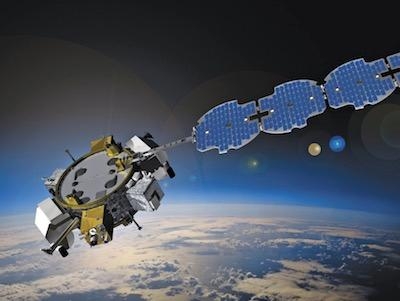Tue, Apr 17, 2018
EAGLE Launched Saturday From Cape Canaveral Air Force Station In Florida
Orbital ATK designed the EAGLE (ESPA Augmented Geostationary Laboratory Experiment) experimental satellite for the U.S. Air Force’s AFSPC-11 mission that successfully launched on United Launch Alliance’s Atlas V vehicle April 14 from Cape Canaveral Air Force Station, Florida. The AFSCPC-11 mission included a second company designed satellite, Mycroft, which is among several Department of Defense experiments hosted on the EAGLE platform as separate payloads.

The EAGLE and Mycroft satellites are based on the company’s ESPAStar™ and ESPASat™ products, which provide modular, cost-effective and highly capable infrastructure resources for hosting technology development and operational payloads. The Orbital ATK-designed EAGLE satellite is the first spacecraft based on the company’s innovative ESPAStar platform. The ESPAStar vehicle can accommodate any combination of up to six hosted or 12 separable, free-flyer payloads in low and geosynchronous orbit and is built to provide an even greater level of access to space. Orbital ATK designed and delivered the EAGLE satellite under a contract with the U.S. Air Force Research Laboratory (AFRL) Space Vehicles Directorate.
After a successful separation from the launch vehicle, EAGLE is hosting several Department of Defense payloads, including Mycroft, the second Orbital ATK-designed satellite to be deployed on the mission. Mycroft, a separable, fly-away experiment, utilized the company’s ESPASat platform for its flight. ESPASat is designed as an affordable GEO bus that can be launched as a secondary payload from an ESPAStar platform.
“Orbital ATK is proud to partner with the U.S. Air Force on the EAGLE and Mycroft missions,” said Chris Long, Vice President, National Security Systems at Orbital ATK. “Our unique capabilities to host separating and non-separating payloads represent a turning point in affordable access to space for small satellites and payloads.”
(Image provided with Orbital ATK news release)
More News
Light Gun A handheld directional light signaling device which emits a brilliant narrow beam of white, green, or red light as selected by the tower controller. The color and type of>[...]
"The journey to this achievement started nearly a decade ago when a freshly commissioned Gentry, driven by a fascination with new technologies and a desire to contribute significan>[...]
Aero Linx: JAARS, Inc. For decades now, we’ve landed planes on narrow rivers and towering mountains. We’ve outfitted boats and vehicles to reach villages that rarely se>[...]
"Our driven and innovative team of military and civilian Airmen delivers combat power daily, ensuring our nation is ready today and tomorrow." Source: General Duke Richardson, AFMC>[...]
Aircraft Conflict Predicted conflict, within EDST of two aircraft, or between aircraft and airspace. A Red alert is used for conflicts when the predicted minimum separation is 5 na>[...]
 ANN's Daily Aero-Term (04.20.24): Light Gun
ANN's Daily Aero-Term (04.20.24): Light Gun Aero-News: Quote of the Day (04.20.24)
Aero-News: Quote of the Day (04.20.24) ANN's Daily Aero-Linx (04.21.24)
ANN's Daily Aero-Linx (04.21.24) Aero-News: Quote of the Day (04.21.24)
Aero-News: Quote of the Day (04.21.24) ANN's Daily Aero-Term (04.21.24): Aircraft Conflict
ANN's Daily Aero-Term (04.21.24): Aircraft Conflict



